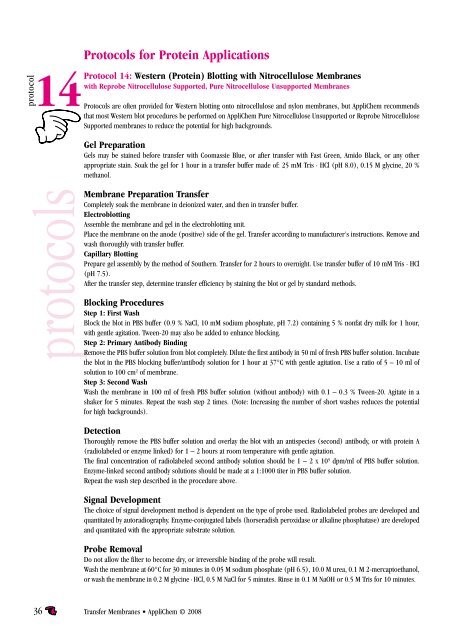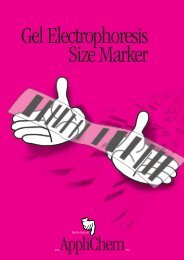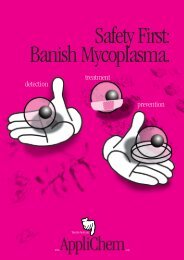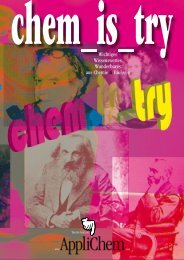Transfer Membranes
Transfer Membranes
Transfer Membranes
You also want an ePaper? Increase the reach of your titles
YUMPU automatically turns print PDFs into web optimized ePapers that Google loves.
protocol<br />
Protocols for Protein Applications<br />
14<br />
Protocol 14: Western (Protein) Blotting with Nitrocellulose <strong>Membranes</strong><br />
with Reprobe Nitrocellulose Supported, Pure Nitrocellulose Unsupported <strong>Membranes</strong><br />
Protocols are often provided for Western blotting onto nitrocellulose and nylon membranes, but AppliChem recommends<br />
that most Western blot procedures be performed on AppliChem Pure Nitrocellulose Unsupported or Reprobe Nitrocellulose<br />
Supported membranes to reduce the potential for high backgrounds.<br />
Gel Preparation<br />
Gels may be stained before transfer with Coomassie Blue, or after transfer with Fast Green, Amido Black, or any other<br />
appropriate stain. Soak the gel for 1 hour in a transfer buffer made of: 25 mM Tris · HCl (pH 8.0), 0.15 M glycine, 20 %<br />
methanol.<br />
protocols<br />
Membrane Preparation <strong>Transfer</strong><br />
Completely soak the membrane in deionized water, and then in transfer buffer.<br />
Electroblotting<br />
Assemble the membrane and gel in the electroblotting unit.<br />
Place the membrane on the anode (positive) side of the gel. <strong>Transfer</strong> according to manufacturer's instructions. Remove and<br />
wash thoroughly with transfer buffer.<br />
Capillary Blotting<br />
Prepare gel assembly by the method of Southern. <strong>Transfer</strong> for 2 hours to overnight. Use transfer buffer of 10 mM Tris · HCl<br />
(pH 7.5).<br />
After the transfer step, determine transfer efficiency by staining the blot or gel by standard methods.<br />
Blocking Procedures<br />
Step 1: First Wash<br />
Block the blot in PBS buffer (0.9 % NaCl, 10 mM sodium phosphate, pH 7.2) containing 5 % nonfat dry milk for 1 hour,<br />
with gentle agitation. Tween-20 may also be added to enhance blocking.<br />
Step 2: Primary Antibody Binding<br />
Remove the PBS buffer solution from blot completely. Dilute the first antibody in 50 ml of fresh PBS buffer solution. Incubate<br />
the blot in the PBS blocking buffer/antibody solution for 1 hour at 37°C with gentle agitation. Use a ratio of 5 – 10 ml of<br />
solution to 100 cm 2 of membrane.<br />
Step 3: Second Wash<br />
Wash the membrane in 100 ml of fresh PBS buffer solution (without antibody) with 0.1 – 0.3 % Tween-20. Agitate in a<br />
shaker for 5 minutes. Repeat the wash step 2 times. (Note: Increasing the number of short washes reduces the potential<br />
for high backgrounds).<br />
Detection<br />
Thoroughly remove the PBS buffer solution and overlay the blot with an antispecies (second) antibody, or with protein A<br />
(radiolabeled or enzyme linked) for 1 – 2 hours at room temperature with gentle agitation.<br />
The final concentration of radiolabeled second antibody solution should be 1 – 2 x 10 5 dpm/ml of PBS buffer solution.<br />
Enzyme-linked second antibody solutions should be made at a 1:1000 titer in PBS buffer solution.<br />
Repeat the wash step described in the procedure above.<br />
Signal Development<br />
The choice of signal development method is dependent on the type of probe used. Radiolabeled probes are developed and<br />
quantitated by autoradiography. Enzyme-conjugated labels (horseradish peroxidase or alkaline phosphatase) are developed<br />
and quantitated with the appropriate substrate solution.<br />
Probe Removal<br />
Do not allow the filter to become dry, or irreversible binding of the probe will result.<br />
Wash the membrane at 60°C for 30 minutes in 0.05 M sodium phosphate (pH 6.5), 10.0 M urea, 0.1 M 2-mercaptoethanol,<br />
or wash the membrane in 0.2 M glycine · HCl, 0.5 M NaCl for 5 minutes. Rinse in 0.1 M NaOH or 0.5 M Tris for 10 minutes.<br />
36 <strong>Transfer</strong> <strong>Membranes</strong> • AppliChem © 2008





